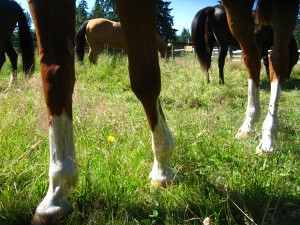Turn Out for a Healthier Horse
A great article from the Canadian Horse Journal found its way to my inbox and I thought I would share.
Do you turn out your horse? For how long? Would love to hear your thoughts!
~~~~~~~~~~~~~~~~~~~~~~~~~~~~~~~~~~~~~~~~~`
Let Loose! Turn Out for a Healthier Horse
By Shantelle Roberts/Canadian Horse Journal

Limiting or eliminating turnout is common practice in the high performance equestrian world, usually in an attempt to avoid equine injuries that would be detrimental to performance goals. But does confinement to a stall or very small paddock cause more problems than it prevents?
In nature, wild horses are herd-oriented and nomadic, spending up to 20 hours a day on the move, covering an average of 15 to 20 kilometres and grazing as they go. Despite thousands of years as a domesticated species, our horses have retained the same basic physiology, instincts, and social needs as their feral counterparts. Insofar as we are able, satisfying these basic needs is imperative for promoting physical, mental, and emotional equine health, and turnout is an important component to consider.
Physical Factors
Studies have demonstrated that horses confined to their stalls are more likely to develop health issues – such as respiratory problems, gastric or colonic ulcers, and impaction colic – that are associated with lack of movement and restricted grazing.
Daily turnout, preferably for at least several hours, not only exposes your horse to the fresh air, exercise, and grazing habits that promote good respiratory and gastrointestinal health, but also helps build general fitness and stronger bones, muscles, and ligaments and tendons.
Additionally, the increased movement encouraged by turnout should improve a horse’s flexibility. Turning your horse out before riding stretches his muscles, which can minimize the risk of training-related injuries and enhance performance.
Mental & Emotional Matters
Horses that receive daily turnout tend to be generally happier and less high strung, improving performance and making training and handling easier.
Without the mental stimulation of being turned out and engaging with other horses, a horse will very quickly become bored and unhappy, and may develop stable vices such as chewing wood, weaving, or stall walking. Additionally, depressed mood in horses, as in people, often has a significant negative impact on performance.
The social aspect of turnout with other horses is also of great benefit to a horse’s mental and emotional health. As herd animals, horses are extremely social by nature. Stabled horses often have limited opportunities to interact with other equines and this can have negative psychological implications. Turning your horse out with a single companion or a small group satisfies his instinctual need for interaction with other horses.
Set Yourself Up for Turnout Success
Before you let your horse loose to begin reaping the physical, mental, and emotional benefits of turnout, make sure the turnout area is devoid of any potential horse hazards. Good horse turnout will have safe, well-maintained fencing, quality pasture without any toxic plants, good footing, a constant source of clean, fresh water, and shelter.


